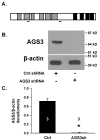Activator of G-protein Signaling 3 Controls Renal Epithelial Cell Survival and ERK5 Activation
- PMID: 27096004
- PMCID: PMC4831271
- DOI: 10.5334/1750-2187-10-5
Activator of G-protein Signaling 3 Controls Renal Epithelial Cell Survival and ERK5 Activation
Abstract
Activator of G-protein signaling 3 (AGS3) is an accessory protein that functions to regulate the activation status of heterotrimeric G-protein subunits. To date, however, the downstream signaling pathways regulated by AGS3 remain to be fully elucidated, particularly in renal epithelial cells. In the present study, normal rat kidney (NRK-52E) proximal tubular epithelial cells were genetically modified to regulate the expression of AGS3 to investigate its role on MAPK and mTOR signaling to control epithelial cell number. Knockdown of endogenous AGS3 protein was associated with a reduced phosphorylated form of ERK5 and increased apoptosis as determined by elevated cleaved caspase-3. In the presence of the ERK5 inhibitor, BIX02189, a significant 2-fold change (P < 0.05) in G2/M transition state was detected compared to control conditions. Neither of the other MAPK, ERK1/2 or p38 MAPK, nor another pro-survival pathway, mTOR, was significantly altered by the changes in AGS3 protein levels in the renal epithelial cells. The selective ERK5 inhibitor, BIX02189, was found to dose-dependently reduce NRK cell number by up to 41% (P < 0.05) compared to control cells. In summary, these findings demonstrated that cell viability was regulated by AGS3 and was associated with ERK5 activation in renal epithelial cells.
Keywords: Activator of G-protein Signaling 3; cell signaling; lentiviral vectors; renal epithelial cell.
Figures






Similar articles
-
Activator of G protein signaling 3 promotes epithelial cell proliferation in PKD.J Am Soc Nephrol. 2010 Aug;21(8):1275-80. doi: 10.1681/ASN.2009121224. Epub 2010 May 20. J Am Soc Nephrol. 2010. PMID: 20488951 Free PMC article.
-
Melamine causes apoptosis of rat kidney epithelial cell line (NRK-52e cells) via excessive intracellular ROS (reactive oxygen species) and the activation of p38 MAPK pathway.Cell Biol Int. 2012 Apr 1;36(4):383-9. doi: 10.1042/CBI20110504. Cell Biol Int. 2012. PMID: 22150157
-
[Molecular mechanisms of mycelium of Cordyceps sinensis ameliorating renal tubular epithelial cells aging induced by D-galactose via inhibiting autophagy-related AMPK/ULK1 signaling activation].Zhongguo Zhong Yao Za Zhi. 2019 Mar;44(6):1258-1265. doi: 10.19540/j.cnki.cjcmm.20181205.001. Zhongguo Zhong Yao Za Zhi. 2019. PMID: 30989992 Chinese.
-
[Molecular mechanism of rhein on inhibiting autophagic protein expression in renal tubular epithelial cells via regulating mTOR signaling pathway activation].Zhongguo Zhong Yao Za Zhi. 2014 Nov;39(21):4090-5. Zhongguo Zhong Yao Za Zhi. 2014. PMID: 25775774 Chinese.
-
Effect of zinc on high glucose-induced epithelial-to-mesenchymal transition in renal tubular epithelial cells.Int J Mol Med. 2015 Jun;35(6):1747-54. doi: 10.3892/ijmm.2015.2170. Epub 2015 Apr 7. Int J Mol Med. 2015. PMID: 25872526
Cited by
-
Intersection of two key signal integrators in the cell: activator of G-protein signaling 3 and dishevelled-2.J Cell Sci. 2020 Sep 4;133(17):jcs247908. doi: 10.1242/jcs.247908. J Cell Sci. 2020. PMID: 32737219 Free PMC article.
-
TRIP13-deficient tubular epithelial cells are susceptible to apoptosis following acute kidney injury.Sci Rep. 2017 Mar 3;7:43196. doi: 10.1038/srep43196. Sci Rep. 2017. PMID: 28256593 Free PMC article.
-
Activator of G protein signaling 3 modulates prostate tumor development and progression.Carcinogenesis. 2019 Dec 31;40(12):1504-1513. doi: 10.1093/carcin/bgz076. Carcinogenesis. 2019. PMID: 31215992 Free PMC article.
References
Grants and funding
LinkOut - more resources
Full Text Sources
Other Literature Sources
Molecular Biology Databases
Research Materials
Miscellaneous

